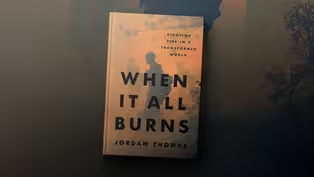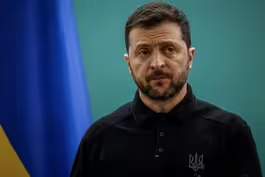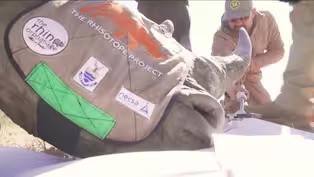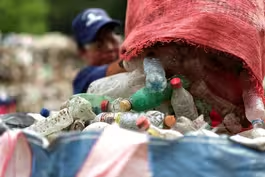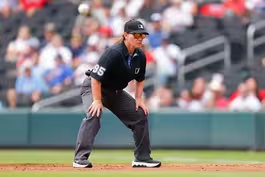
August 9, 2025 - PBS News Weekend full episode
8/9/2025 | 24m 9sVideo has Closed Captions
August 9, 2025 - PBS News Weekend full episode
Saturday on PBS News Weekend, a new study highlights the growing health dangers of plastic pollution. As megafires become more common, an anthropologist gives a firsthand account of a historic season with the elite Los Padres Hotshots. History is made as a woman umpires a regular-season MLB game for the first time. Plus, scientists in South Africa make rhino horns radioactive to fight poaching.
Problems playing video? | Closed Captioning Feedback
Problems playing video? | Closed Captioning Feedback
Major corporate funding for the PBS News Hour is provided by BDO, BNSF, Consumer Cellular, American Cruise Lines, and Raymond James. Funding for the PBS NewsHour Weekend is provided by...

August 9, 2025 - PBS News Weekend full episode
8/9/2025 | 24m 9sVideo has Closed Captions
Saturday on PBS News Weekend, a new study highlights the growing health dangers of plastic pollution. As megafires become more common, an anthropologist gives a firsthand account of a historic season with the elite Los Padres Hotshots. History is made as a woman umpires a regular-season MLB game for the first time. Plus, scientists in South Africa make rhino horns radioactive to fight poaching.
Problems playing video? | Closed Captioning Feedback
How to Watch PBS News Hour
PBS News Hour is available to stream on pbs.org and the free PBS App, available on iPhone, Apple TV, Android TV, Android smartphones, Amazon Fire TV, Amazon Fire Tablet, Roku, Samsung Smart TV, and Vizio.
Providing Support for PBS.org
Learn Moreabout PBS online sponsorshipJOHN YANG: Tonight on PBS News Weekend, Ukrainian President Volodymyr Zelenskyy says he won't give up any territory to Russia after President Trump suggests a land swap to end the war.
Then, history is made as a woman umpires a regular season game for the first time in Major League baseball's nearly 150 year history.
And scientists in South Africa are making endangered rhinos horns radioactive to save them from poaching.
MAN: You can't take that horn anywhere.
It is radioactive.
You can't take it through any airport, any harbor, any customs office.
I'm telling you, this could be the holy grail to save the species.
(BREAK) JOHN YANG: Good evening.
I'm John Yang.
We begin tonight in Ukraine, where President Volodymyr Zelenskyy has flatly rejected President Trump's suggestion that a peace deal between Ukraine and Russia might include the two nations swapping territory.
In advance of Mr. Trump's summit with Russian President Vladimir Putin in Alaska next week, Zelenskyy said he wouldn't agree to anything that comes out of any meeting that leaves his nation on the sidelines.
He accused Russia of stalling.
VOLODYMYR ZELENSKYY, Ukrainian President (through translator): Russia started it and is dragging it out, ignoring all deadlines.
And that is the problem, not something else.
The answer to the Ukrainian territorial question already is in the constitution of Ukraine.
No one will deviate from this and no one will be able to.
Ukrainians will not gift their land to the occupier.
JOHN YANG: Mr. Trump had set a Friday deadline for Russia to end the war or face additional sanctions.
But that deadline came and went without any new penalties.
In the war in Gaza, growing outrage over Israel's plan to take control of Gaza City, including among Israelis.
Thousands rallied outside the Israeli military headquarters in Tel Aviv.
Family members of hostages as well as anti-government protesters demanded that Prime Minister Benjamin Netanyahu make a deal with Hamas to release all of the hostages still in Gaza.
This as attempts to provide aid in Gaza are increasingly troubled.
A pallet of aid air dropped into central Gaza today struck and killed a 15 year old.
The United Nations says that more than 1,000 people have been killed trying to reach aid.
80-years after the United States detonated an atomic bomb over Nagasaki, Japan, representatives from more than 90 nations gathered there to honor the tens of thousands of lives lost.
Entire sections of the city were leveled on August 9, 1945, when the United States dropped the bomb, nicknamed Fat Man instantly killing an estimated 27,000 people.
Five days later, Japan surrendered, ending World War II.
The Nagasaki attack followed the dropping of an atomic bomb on Hiroshima that killed 140,000 people.
The crew that relieved two U.S. astronauts stranded on the International Space Station has returned home.
NASA astronauts Anne McClane and Nicole Ayers along with counterparts from Japan and Russia splashed down today off the coast of Southern California.
The four-person crew headed to the space station in March to replace astronauts Butch Wilmore and Suni Williams whose planned week long stay at the space station ended up lasting nine months.
In Geneva, negotiators from 175 nations are trying to hammer out the first ever legally binding treaty on plastic pollution.
The key sticking point is whether it should mandate cuts in plastic production.
Oil producing nations including the United States oppose that as fossil fuels are a key ingredient in plastics.
The urgency of the talks was underscored this week by a new study published in the medical journal The Lancet.
It calls plastics a grave growing and under recognized danger to human and planetary health.
Tracey Woodruff is a professor at the UC San Francisco Medical School and one of the authors of the Lancet study.
Tracey, A grave, growing and under recognized danger.
What is that danger?
Explain the danger to us.
TRACEY WOODRUFF, UC San Francisco School of Medicine: Plastic contains thousands of toxic chemicals.
Some of them we know something about and some of them we don't know anything about.
But the ones that we do know about, we know that they can lead to increased risk of multiple different types of chronic health effects.
For example, one chemical that's used commonly in plastics to which we are all exposed are phthalates.
These are chemicals that are used in everything from vinyl flooring, curtains, plastic couches, even in your car, cosmetics, fragrances.
These chemicals are ubiquitous.
They're measured in everybody.
And we know they increase the risk of multiple adverse health conditions like obesity and diabetes and they can increase the risk of preterm birth.
There's also an increased production of plastics.
Currently planned plastic production will triple in the next 30 years.
That means more plastic products and more plastic chemicals to which we will be exposed.
JOHN YANG: Talk about the production picking up the pace.
Why is it accelerating?
TRACEY WOODRUFF: Plastics are made from fossil fuels, oil and gas.
And the fossil fuel industry is turning to plastics to stay profitable making plastic and the petrochemicals used in plastic is more profitable than using it for fuel and energy and electricity.
So as the world uses less oil in some cases to address climate change concerns, the fossil fuel industry is shifting its focus to producing more plastic and plastic related chemicals to maintain and increase their profits.
JOHN YANG: You know, we see recycling bins everywhere now on the street and offices.
What impact or what effect does recycling have?
TRACEY WOODRUFF: Well, recycling is pretty much a myth that's been sold to us by the fossil fuel industry.
And in fact, a report just came out this week talking about how those that the fossil fuel industry knew that you can't actually really recycle plastic.
The fact is that less than 10 percent of plastic is recycled and only 1 percent is recycled twice.
And what that means is that a lot of this plastic we're being told, is being recycled to make us feel better, but it's really going into the waste stream.
It's degrading in the environment, it's degrading into all of these, varied in the oceans, in fish, and then it's getting into us.
So the reality is recycling is not the solution.
JOHN YANG: There's been a lot of talk about microplastics being so pervasive.
Help us understand what that is and do we know what the effects are of having microplastics in our bodies?
TRACEY WOODRUFF: Yeah, microplastics, they're essentially little plastics and they're very small, usually smaller than the human eye can see.
And they're basic.
They come from the degradation of all these many plastics that are being produced by these fossil fuel companies.
And we know that people carry little bits of microplastics in their body because they've been measured in every part of the body that they've been looked at.
So everything from breast milk to blood to feces, even in your brain.
JOHN YANG: These talks in Geneva, they had hoped to conclude this by the end of 2024.
Obviously they haven't.
What's at stake in these talks?
TRACEY WOODRUFF: Well, the health of everybody on this planet is at stake in these talks.
The goal of the pla -- of the countries that want to see something done about plastic pollution is to identify the hazardous chemicals in the plastics and reduce or eliminate them.
The goal of the fossil fuel producing countries is to basically increase plastic production.
And they are deviating the plastic negotiation treaties by focusing on recycling, which I have said is not really the solution to plastic production.
And so because these countries or the projected estimates are to triple by 26 plastic production, it really is an important inflection point in how we as well really as part of the global community, decide how we want to address plastics and the plastic related chemicals which we already know are already resulting in adverse human health effects around the globe.
JOHN YANG: Tracey Woodruff of UC San Francisco Medical School, thank you very much.
TRACEY WOODRUFF: Well, thank you.
JOHN YANG: Still to come on PBS News Weekend, the first woman umpire in nearly a century and a half of big league baseball and how scientists are making rhino horns radioactive to save the endangered species from poachers.
(BREAK) JOHN YANG: California fire officials say a massive wildfire in Southern California has reached mega fire status.
Fueled by near 100 degree heat and bone dry conditions, the Gifford fire north of Santa Barbara has already burned more than 104,000 acres.
That's an area bigger than Atlanta.
Mega fires, which burned more than 100,000 acres have become increasingly common in recent years, testing the men and women who fight them.
A new book, "When It All Burns: Fighting Fire in a Transformed World" is the firsthand account of a season with a team of elite firefighters, the Los Padres Hotshots.
The author is Jordan Thomas, who's also anthropologist.
Jordan Thomas, help us understand what is it like to be on the front lines of a wildfire.
JORDAN THOMAS, Author, When It All Burns: Fighting Fire in a Transformed World": These are some of the largest wildfires that humans have ever encountered in our recorded history.
So science is having a hard time even understanding what these wildfires are going to do.
So what it's actually like to fight wildfires is you're living on some of the most extreme edges of the climate crisis in triple digit heat, basically mountaineering with chainsaws to remove fuel from the edges of fires.
And so it takes an extreme amount of tactical athleticism and a really intense level of knowledge of landscapes and fire behavior as well.
JOHN YANG: Talk about that knowledge of landscapes.
You've got to be constantly assessing the landscape as you're fighting the fire, right?
JORDAN THOMAS: Right, yeah, exactly.
So you have to be paying attention to the vegetation, to the slope of the landscape, and to changes in all these different weather patterns, including the temperature, the humidity and the wind.
Because all of these things change what fire does.
And when you're working on the edges of fires, day after day, hour after hour, week after week, any of these changes can put you in extremely dangerous situations.
JOHN YANG: The point you made at the beginning about how these wildfires are different or seem to be different, you write in the book that the recent wildfires have transformed fundamental assumptions about how fireworks.
Explain that.
JORDAN THOMAS: So people I've worked with, when they started their career, they may have encountered one megafire in their entire career, but there's multiple megafires burning across the American west now.
We fought four during the time I was writing the book.
They're becoming common.
18 of the 20 largest wildfires in California's recorded history of burning just the past two decades.
So what does that mean?
In a fundamental sense it means that we often don't know what these fires are going to do day by day.
We don't know what their ecological impacts are going to be, we don't know how they're going to behave.
And that sounds dangerous in an abstract sense, but it's also incredibly dangerous for wildland firefighters on the ground.
For example, fires, usually, their behavior usually really calms down at night.
That's what we've come to expect.
In 2020 a wildfire that I was on, it doubled in size overnight after we almost had it contained, and it overtook 15 firefighters and a lot of them were injured.
So things with the climate crisis that seem abstract are often matters of life and death for wildland firefighters.
JOHN YANG: And talk about that effect.
The climate crisis, how is the climate crisis affecting this?
JORDAN THOMAS: So you have multiple layers.
On a broad layer, you have broad changes in temperature across entire landscapes.
It takes more water out of the vegetation, out of the trees, dries them out, makes them more flammable.
You have other changes that intersect with that.
Like there's less precipitation falling as snow.
That means that there's less water running throughout the landscapes and snow melt throughout the year, which means that the lands dry out quicker.
Layer drought on top of that layer, insect infestations on top of that, you get really sick landscapes.
And then you're also way more likely to have intense heat waves.
And that just sucks the rest of the moisture out of the landscapes as well.
And you get really explosive fire behavior.
Then when you get these unprecedented heat waves, you know, like 120 degrees, that also makes them way more difficult to suppress, which endangers communities and in the area as well.
So, there's multiple layers, but they all intersect with climate change in a really dangerous, explosive situation.
JOHN YANG: In terms of history, in your book you talk about how centuries ago, the indigenous people in California coexisted with fire, lived with fire, but then the white European settlers came in and the focus became on fire suppression.
What effect did that have?
JORDAN THOMAS: So it's important to keep in mind when we're talking about this, that California is one of the most fire evolved regions on Earth.
Many of the ecosystems and many of the plant species actually rely on fire to reproduce.
Now indigenous people knew this and lived in California for at least 10,000 years before Europeans arrived.
And plants were the basis of indigenous economies.
So, indigenous people knew to use fire to shape sorts of plants that they needed.
And this really transformed California's ecosystem.
So most of the fire California encountered was actually lit by indigenous people before Europeans arrived.
So one of the first acts that Europeans did when they took over the Spanish, they criminalized the use of fire as a way to criminalize indigenous economies.
Now this was a start of a long history of fire suppression that went from that first criminalization up until the modern day, where we treat fire as an enemy, where we try to put fire out.
When you take fire away from landscapes that need it, you make those landscapes sick.
You get fuels accumulation in forests.
You get insect infestations that you wouldn't otherwise if you were burning.
And the culmination of this is you sort of lay the kindling that climate change is really.
It's like dropping a match on top of the kindling.
JOHN YANG: Jordan Thomas, author of "When It All Burns," thank you very much.
JORDAN THOMAS: Thank you.
JOHN YANG: History was made in Atlanta this afternoon when Jen Pawol took the field as the first woman to umpire a regular season game in Major League Baseball's nearly 150 year history.
She was on the basis for both games of a double header between the Miami Marlins and the Atlanta Braves.
In tomorrow's game, she's going to behind the plate calling balls and strikes.
Earlier, I spoke with Chelsea Janes, The Washington Post national baseball writer.
I asked her how Pawol found out she'd be working today's games.
CHELSEA JANES, The Washington Post: She said she was in her hotel room in Nashville and got called to a conference call with two MLB officials who were in charge of umpiring.
And they told her, you know, this is your moment.
And she called her crew chief, so the guy who's in charge this weekend, and they started yelling over the phone.
You know, a grown man who generally has to kind of maintain decorum on a baseball field, just kind of screaming into the phone with her, which is just really kind of special to hear about.
JOHN YANG: Tell me a little bit about her background.
How did she become interested in umpiring?
CHELSEA JANES: Jen played college softball.
She wanted to umpire from the day she first tried it, even in high school, like as a throwaway side job.
And when she got done playing, she kind of looked into it, umpired high school baseball in upstate New York, even umpired college softball in New England and New York.
So she was pretty much at the highest level she could get to for that and wanted more, wanted it to be a career instead of something she got paid a couple hundred bucks a weekend to do.
So she, you know, ended up hearing about a clinic.
And at a clinic, she met a major league umpire named Ted Barrett.
And he said, hey, you're pretty good at this.
I also host a clinic down in Atlanta.
She attended it and was funneled into the minor league system from there.
JOHN YANG: Talk about how that works, how umpires work their way through the minor league system.
CHELSEA JANES: It used to be the kind of thing you had to sort of buy your way into these schools and prove yourself and Major League Baseball said that's.
That's eliminating too many people.
So they started hosting more open clinics that you could sign up for and learn, and they would evaluate you there.
That's what Jen did.
And she kept passing the test level by level.
And a few years ago, she got promoted to AAA, which is the highest minor league level.
She not only got promoted there, but she was given the championship game because she did so well.
And, you know, after that, sort of got on the short list to make it to major league spring training, and this year, finally gotten this pool of umpires where if they need someone to fill in like they did this weekend, they could choose her, and they did.
So she's not full time in the big leagues yet.
Those jobs do not come open very often.
People cling to them as you would think they would, but when one opens, she's close.
JOHN YANG: You mentioned Ted Barrett, you mentioned her crew chief today.
Has she gotten a lot of support from both former and current umpires?
CHELSEA JANES: She really has, and I think it's fair to wonder if that was going to be the case.
You know, this is something that.
It's very different, and it's a role where you're not used to seeing women.
And, you know, even I - - when I first heard about this, I was like, well, the players yell at her more.
Will they yell at her less?
Will they take her seriously?
But, you know, I think once you see her handle this, you kind of understand, oh, she handles herself in a way where you really don't notice until you think about it.
And I think that's what those umpires saw too.
JOHN YANG: You know, you pointed out in your story in The Post that Major League Baseball almost had a robo calling balls and strikes before they had a woman calling balls and strikes.
How does baseball compare with the other professional sports in this sense?
CHELSEA JANES: They're a little behind.
The NBA had female referees in the late 90s.
The NFL had them about a decade ago, I believe.
The NHL still hasn't had one.
I think that the general consensus is part of that is the breaking up fights part is a little bit tricky.
Baseball was behind.
She's been in the pipeline for a long time, and now there are more women there.
But, yeah, they've tested automatic balls and strikes, and they're going to introduce them on a limited basis.
But, yeah, they got farther with that more quickly than they did with women.
And, you know, I don't think that's too surprising.
JOHN YANG: Talk about that pipeline.
Are there more women coming up there?
CHELSEA JANES: Are there are, I believe, six umpires in the minor leagues right now.
I believe that's counting Jen Pawol.
They're being vetted the same way that Jen was and that the male umpires are.
You probably won't see them at these levels for quite some time.
It just takes a while.
But yeah, there's more women following in her footsteps, and I think there's reason to believe that we'll see more of them in the big league soon.
JOHN YANG: In the past, a woman had come close to making the majors.
Is that right?
CHELEA JANES: Pam Postima came really close in the late 80s and just didn't find a league that was receptive to her.
She's been in touch with Jen Pawol throughout this process, and Jen said that when she got promoted to AAA a little over a year ago, she went to dinner with Pam and the last thing Pam said to her was, get it done.
You know, get it done.
And so when she got the call this week, you know, Jen said she texted her, you know, I'm getting it done.
JOHN YANG: You talked about how the umpires saw what she does and have supported her.
Any sense of the minor leagues, of what the players have reacted?
CHELSEA JANES: She shared a story about one third baseman who heard the news this week and said, hey, we've done this at every level and I'll see you in the big leagues, you know, and I think they respect it.
I've only seen people be really polite and go over and fist bumper like they do everyone else.
But I think people also, a little bit, even have their eye on her, like, hey, you know, go do this and.
And so I think it's been kind of a really pleasant surprise to see the support she's gotten.
JOHN YANG: Chelsea Janes of the Washington Post, thank you very much.
CHELEA JONES: Thanks for having me.
JOHN YANG: Finally tonight, the black market trade in rhino horns is driving these species to near extinction.
Now scientists at a rhino orphanage in the Bushveld of South Africa are trying to protect them from poaching in a rather surprising way.
JOHN YANG (voice-over): The first step is to carefully sedate beasts that can weigh up to two and a half tons.
Then the scientists get to work with a drill.
They insert radioactive isotopes into the rhino's horns in amounts too small to affect their health.
It's called the Rhizotope Project.
James Larkin of the University of Witwatersrand set it up in 2021.
JAMES LAKRIN, University of Witwatersrand: By making the horns radioactive, we are making those horns, devaluing those horns.
In the eyes of the poacher and the end users, no one wants a radioactive horn.
JOHN YANG (voice-over): South Africa has the world's largest population of rhinos, and hundreds of them are poached every year.
It's a major threat to the critically endangered rhinos driven by the lucrative black market for their horns, which are popular in some Asian countries, in traditional medicine and as status symbols.
The goal of the Rhizotope project is to make horns virtually impossible to traffic.
ARRIE VAN DEVENTER, The Rhino Orphanage: All these rhinos are here because they were orphaned, because their mothers were shot.
They were poached because of the value of the rhino horn.
Now with the Rhizotope Project, you can't take that horn anywhere.
It is radioactive.
You can't take it through any airport, any harbor, any customs office.
Sirens go off.
It is wonderful.
I'm telling you, this could be the holy grail to save this species.
JOHN YANG (voice-over): The effort is supported by the International Atomic Energy Agency.
A pilot study involving 20 rhinos proved that it's safe and effective.
Now scientists are working to expand to a broader scale and see if the idea can be applied to other species prized by poachers.
JOHN YANG: And that is PBS News Weekend for this Saturday.
I'm John Yang.
For all of my colleagues, thanks for joining us.
See you tomorrow.
New book recounts megafire season with Los Padres Hotshots
Video has Closed Captions
Clip: 8/9/2025 | 5m 33s | ‘When It All Burns’ recounts a historic megafire season with the elite Los Padres Hotshots (5m 33s)
News Wrap: Zelenskyy says Ukraine won’t cede land to Russia
Video has Closed Captions
Clip: 8/9/2025 | 2m 37s | News Wrap: Zelenskyy says Ukraine won’t give up territory to end war with Russia (2m 37s)
Scientists make rhino horns radioactive to fight poachers
Video has Closed Captions
Clip: 8/9/2025 | 2m 9s | How radioactive rhino horns could help save the species from poachers (2m 9s)
Study highlights ‘grave’ health dangers of plastic pollution
Video has Closed Captions
Clip: 8/9/2025 | 4m 48s | New study highlights ‘grave, growing’ danger of plastic pollution to world’s health (4m 48s)
What Pawol’s MLB debut means for the future of women umpires
Video has Closed Captions
Clip: 8/9/2025 | 5m 31s | What Jen Pawol’s debut means for the future of women umpires in Major League Baseball (5m 31s)
Providing Support for PBS.org
Learn Moreabout PBS online sponsorshipSupport for PBS provided by:
Major corporate funding for the PBS News Hour is provided by BDO, BNSF, Consumer Cellular, American Cruise Lines, and Raymond James. Funding for the PBS NewsHour Weekend is provided by...
